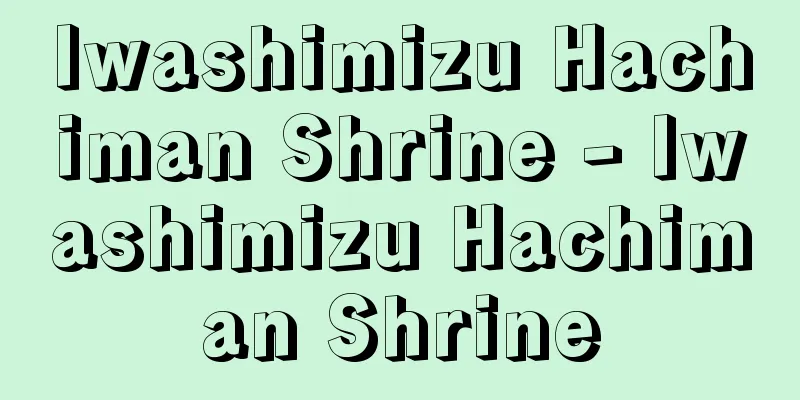Iwashimizu Hachiman Shrine - Iwashimizu Hachiman Shrine

|
It is located in Takabo, Yawata City, Kyoto Prefecture. It is located on the hill of Otokoyama and is also called Otokoyama Hachiman Shrine. The deities enshrined are Hondawake no Mikoto (Emperor Ojin), Himeokami, and Okinagatarashihime no Mikoto (Empress Jingu). In 859 (Jogan 1), a monk named Gyokyo from Daian-ji Temple in Nara received an oracle from Usa Hachiman Okami in Buzen Province (Oita Prefecture), and made a petition to him. He built a six-story hall similar to Usa Hachiman Shrine, and enshrined the sacred seal there the following year, which is said to be the origin of the shrine's founding. In 863, Gyōkyō issued an official order to make Gokokuji a shrine temple, and to make it a palace temple following the example of Bungo Yusuhara Palace. The main temple was enshrined to protect the capital, and was particularly revered by the Imperial family, with many successive emperors making visits and offerings to the temple. In 869, in the imperial decree to quell the Silla invasion, Sumeōmikami (Hachiman) of Iwashimizu was made the ancestor of our nation, and in 872, the arrival of Bohai was announced. In 940 (Tenkei 3), prayers were offered for the quelling of the Fujiwara no Sumitomo Rebellion, and then a fief was given in gratitude for the quelling of the Taira no Masakado Rebellion. In April 942 (Tenkei 5), the Iwashimizu Extraordinary Festival began with the offering of sacred treasures, songs and dances to commemorate the quelling of the Masakado-Sumitomo Rebellion. In 1128 (Taiji 3), Empress Fujiwara no Shoshi offered three portable shrines at the extraordinary festival. The first imperial visit was made by Cloistered Emperor Enyu on January 21, 989 (Eizo 1), and it is said that there were over 240 imperial visits by the time of the imperial visit in 1877 (Meiji 10). The offerings include offerings upon enthronement (Yoshinohohei), offerings upon the enthronement prayers (Kitou), offerings upon the Daijosai (Great Josai), offerings as Daishin Treasure Envoys, and once-in-a-lifetime Buddha Relic Envoys (Busharishi). After Minamoto no Yorinobu, both Yoriyoshi and Yoshiie revered the main shrine as the ancestor of the Minamoto clan, and enshrined shrines such as Tsurugaoka Hachimangu in Kamakura in various places. In 1185 (Bun'ei 1), Yoritomo donated land for the shrine, and in 1191 (Kenkyu 2), he protected the land of the betto. After that, Minamoto clan warriors also enshrined and revered Hachiman in various places. In 1235 (Kasei 1), a diviner tried to make a complaint by waving a portable shrine, so the Imperial Court donated manors in Iga (Mie Prefecture) and Inaba (Tottori Prefecture). When the Mongol invasion occurred, the Emperor visited the shrine to pray, and it is said that he received divine blessings. After the Muromachi period, there was a lot of seizure of the shrine's land, but in the Edo period, the shogun came to revere the shrine and donated red seal land to it. In August 1869 (Meiji 2), the name of Iwashimizu was changed to Otokoyama, but in January 1918 (Taisho 7), it was reinstated to Iwashimizu. It is said to be the second imperial shrine after Ise Jingu, and in 1081 (Eiho 1), it was listed as one of the 22 shrines, and in 1871 (Meiji 4), it became a Kanpei Taisha (Great Shrine of the Imperial Family), and in 1883, it became an imperial shrine along with Kamo Jinja Shrine. There were no priests at the main shrine, but in 876 (Jogan 18), Kino Mitoyo, a member of Gyonori's family, was appointed as the head priest of Usa Shrine, and this position was inherited by successive generations. However, Usa Mirokuji's Lecture Gennomoto took the name of Ki and became the head priest, and his grandson took over as the shrine official, which later became the Tanaka family and the Zenpoji family. The duties of the position were controlled by the Kengyo, and the shrine affairs were handled by the betto, but below them were the Gon betto and Shuri betto, who were distinguished from the shrine official Sankosho. In the medieval Shinjin system, the Shinjin of the subordinate shrine, the Hachiman Oyamazaki rikyu, was the most powerful. The shrine building burned down three times, during the Hoen era (1135-41), the Kenmu era (1334-38), and the Eisho era (1504-21), and the current shrine building (a national treasure) was built by Tokugawa Iemitsu in 1631 (Kan'ei 8), and is in the Hachiman style, with three buildings connected horizontally. The shrine treasures, the Iwashimizu Hachiman Shrine Documents, one Gorin-to pagoda, and one stone lantern, are all important national cultural properties. The annual festival on September 15th (Iwashimizu Festival) used to be called Hojoe, and was one of the three major imperial festivals along with the Kamo Festival and the Kasuga Festival. [Nakano Hatano] Iwashimizu Hachiman Shrine territoryIt was called the Guji territory because it was managed by the head priest of Gokokuji Temple, which was a shrine temple. In 940 (Tenkei 3), 20 fiefs (10 each in Yamashiro and Tamba) were donated as thanks for putting down the Taira no Masakado Rebellion, and by the end of the Heian period, the number of fiefs had grown to over 300. Starting with Yada-sho in Kawachi Province (Osaka Prefecture), which was developed in 936 (Shohei 6), there were 34 manors in six provinces: Yamashiro (Kyoto Prefecture), Kawachi, Izumi (Osaka Prefecture), Mino (Gifu Prefecture), Tamba (Hyogo Prefecture), and Kii (Wakayama Prefecture) in 1072 (Enkyu 4), but 13 manors were discontinued in the same year due to a reorganization of manors. However, people had a strong faith in this shrine, and since Minamoto no Yorinobu, it has been revered as the clan deity of the Minamoto clan, and by 1158 (Hogen 3), the shrine's territory had reached 100 locations across 33 provinces. It was exempt from the average provincial taxes, such as the Ise Shrine service tax and rice farming tax, and the Kamakura shogunate also donated a manor and provided protection, such as suppressing the misconduct of samurai on the shrine's territory. The territory of Gokurakuji, the lodgings of Gokokuji, also numbered 37 locations in 1158 and was placed under the management of the Gokokuji betto. The shrine family was divided into various temples, such as Tanaka and Zenpoji, and each temple also had its own territory. Among them, Tanaka-bo, who also served as the inspector of Hakozaki Shrine in Chikuzen Province (Fukuoka Prefecture) in 1131 (Tensho 1), controlled the shrine's territory. Zenpo-ji also controlled the Miroku-ji Temple of Usa Hachiman Shrine in Buzen Province (Oita Prefecture), which had 104 temple lands. Thus, in the Kamakura and Muromachi periods, the total number of temple lands reached over 400. In the early modern period, in addition to the 6,300 koku of red seal land, there were over 2,300 koku of land donated by feudal lords or purchased by shrine priests and priests, leading up to the Meiji Restoration. [Masayoshi Kamiyokote] [Reference] |Tower gate and corridor (both designated as important cultural properties by the national government). Yawata City, Kyoto Prefecture © Yawata City Tourism Association "> Iwashimizu Hachiman Shrine Source: Shogakukan Encyclopedia Nipponica About Encyclopedia Nipponica Information | Legend |
|
京都府八幡(やわた)市八幡高坊(たかぼう)に鎮座。男山(おとこやま)の丘陵上にあり、男山八幡宮ともいう。祭神は誉田別尊(ほんだわけのみこと)(応神(おうじん)天皇)、比咩大神(ひめおおかみ)、息長帯比売命(おきながたらしひめのみこと)(神功(じんぐう)皇后)。859年(貞観1)奈良大安寺の僧行教(ぎょうきょう)が豊前(ぶぜん)国(大分県)宇佐八幡大神(うさはちまんおおかみ)の託宣を受け奏請(そうせい)し、宇佐八幡宮に準じて6宇の宝殿を造営し、翌年ここに神璽(しんじ)を奉安したのが創立の起源という。863年行教は官符を申し下し、護国寺を神宮寺とし、豊後由原宮(ぶんごゆすはらぐう)に倣って宮寺となる。本社は都の守護のために勧請(かんじょう)されたのでとくに皇室の尊崇が厚く、歴代天皇等の行幸啓、奉幣が多く行われた。869年新羅(しらぎ)の来寇(らいこう)鎮定の宣命(せんみょう)には石清水の皇大神(すめおおみかみ)(八幡神)はわが朝の大祖とされ、872年には渤海(ぼっかい)来朝を告げられた。940年(天慶3)藤原純友(すみとも)の乱の平定を祈り、ついで平将門(まさかど)の乱の平定を謝して封戸(ふこ)を寄せられ、942年(天慶5)4月には将門・純友の乱平定で神宝、歌舞を奉られ石清水臨時祭が始まった。1128年(大治3)の臨時祭には中宮藤原彰子(しょうし)が3基の神輿(しんよ)を奉った。行幸は989年(永祚1)正月21日の円融(えんゆう)法皇の参詣(さんけい)を初めとし、1877年(明治10)の行幸まで240度余りあったという。奉幣は即位由奉幣(よしのほうへい)、同祈祷(きとう)、大嘗祭(だいじょうさい)由奉幣、大神宝使、一代一度仏舎利使(ぶっしゃりし)などである。 源頼信(よりのぶ)以後頼義(よりよし)、義家(よしいえ)ともに本社を源氏の祖神として崇敬し、鎌倉鶴岡(つるがおか)八幡宮などを各地に勧請、1185年(文治1)頼朝(よりとも)は神領を寄進し、1191年(建久2)には別当領を保護した。以後、源氏の武士も各地に八幡神を勧請し崇敬した。1235年(嘉禎1)には神人(じにん)が神輿を振って訴えようとしたため、朝廷は伊賀(いが)(三重県)、因幡(いなば)(鳥取県)国内の荘園(しょうえん)を寄進した。蒙古(もうこ)来寇の際には、天皇行幸して祈願し、神験を得たという。室町時代以後、神領の押領(おうりょう)が激しかったが、江戸時代になると、将軍が崇敬し、朱印地を寄進した。1869年(明治2)8月、石清水の名称は、男山に改められたが、1918年(大正7)1月石清水に復称された。伊勢(いせ)神宮に次ぐ第二の宗廟(そうびょう)といわれ、1081年(永保1)には二十二社に列し、1871年(明治4)に官幣大社、1883年に賀茂(かも)神社とともに勅祭社となる。 本宮には神官はなかったが、876年(貞観18)行教の一族紀御豊(きのみとよ)が宇佐宮に準じて神主(かんぬし)に任ぜられ、代々これを相続したが、宇佐弥勒寺(みろくじ)講師元命が紀氏を称して別当となり、外孫が祠官(しかん)を襲い、のちに田中家、善法寺(ぜんぽうじ)家となった。その職掌は検校(けんぎょう)が支配し、宮寺務は別当があたったが、下に権(ごん)別当、修理(しゅり)別当があり、祠官三綱所司と区別された。中世の神人制では末社離宮八幡大山崎(おおやまざき)神人が、もっとも、優勢であった。 社殿は保延(ほうえん)年間(1135~41)、建武(けんむ)年間(1334~38)、永正(えいしょう)年間(1504~21)の3回炎上し、現社殿(国宝)は1631年(寛永8)徳川家光(いえみつ)の造営で、八幡造であるが3宇が横に連結する。社宝の「石清水八幡宮文書」、五輪塔、石造灯籠(とうろう)各1基は国の重要文化財。9月15日の例祭(石清水祭)は、古くは放生会(ほうじょうえ)といい、賀茂祭、春日(かすが)祭とともに三大勅祭の一つであった。 [中野幡能] 石清水八幡宮領神宮寺である護国寺別当が管理したので、宮寺(ぐうじ)領とよばれた。940年(天慶3)平将門の乱の平定を謝して20戸の封戸(ふこ)(山城(やましろ)、丹波(たんば)各10戸)が寄せられたのが最初で、平安時代の末には封戸は300余戸に及んだ。荘園(しょうえん)は、936年(承平6)に開発された河内(かわち)国(大阪府)矢田庄(しょう)をはじめとして、1072年(延久4)には山城(京都府)、河内、和泉(いずみ)(大阪府)、美濃(みの)(岐阜県)、丹波(兵庫県)、紀伊(和歌山県)の6か国に34か所あったが、同年、荘園整理によって13か所が停止された。しかし当宮に対する人々の信仰は厚く、とくに源頼信(よりのぶ)以来、源氏の氏神として尊崇されたこともあって、1158年(保元3)には宮寺領は33か国、100か所に及んだ。伊勢(いせ)神宮役夫工米(やくぶくまい)などの一国平均の諸役も免除され、さらに鎌倉幕府も荘園を寄進し、宮寺領における武士の非法を抑えるなど、保護を加えた。護国寺の宿院である極楽寺(ごくらくじ)領も、58年には37か所あり、護国寺別当の管理下に置かれた。社家は田中、善法寺などの諸坊に分かれたが、各坊にも所領があった。なかでも田中坊は、1131年(天承1)以来、筑前(ちくぜん)国(福岡県)筥崎宮検校(はこざきぐうけんぎょう)を兼ねて同宮領を支配した。また善法寺は、104か所の寺領をもつ豊前(ぶぜん)国(大分県)宇佐八幡宮弥勒寺を支配した。かくて鎌倉・室町時代の宮寺領全体で400余か所に及んだ。近世には6300余石の朱印地のほか、大名から寄進されたり、社僧、神官が買得した地が2300余石あり、明治維新に至った。 [上横手雅敬] [参照項目] |楼門と廻廊(ともに国指定重要文化財)。京都府八幡市©八幡市観光協会"> 石清水八幡宮 出典 小学館 日本大百科全書(ニッポニカ)日本大百科全書(ニッポニカ)について 情報 | 凡例 |
>>: Iwashimizu Festival - Iwashimizusai
Recommend
Lady-of-the-night
...They have a strong fragrance. The large-flower...
Iobates - Iobates
…After accidentally killing someone, he fled to A...
truck system
...wages paid not in currency but in goods or sub...
Local Lipschitz condition
… When f1 , …, fn are defined on an open set G in...
Police officer
…Up until the Muromachi period, aristocrats and s...
Naturalism
In the broadest sense, this is a position that con...
Snack - Snack (English spelling)
The original meaning is to have a bite, a small a...
Maleic Anhydride - Maleic Anhydride
2,5-furandione. C 4 H 2 O 3 (98.06). In industria...
Bandage - Houtai
This refers to the mechanical operation of applyi...
Jasminum primulinum
…[Murata Gen]. … *Some of the terminology that me...
Li Rusong
A military commander in the late Ming Dynasty in ...
Kurihan Kaido - Kurihan Kaido
This road connects Imazu Port in Omi Province on t...
Sigismund (King of Burgundy)
…Furthermore, in terms of religion, the Burgundia...
Oesho - Oesho
...The origin of Kannon is thought to be influenc...
Jishu -
A sect of Pure Land Buddhism founded by the late ...









